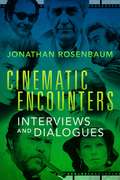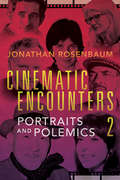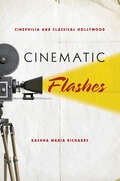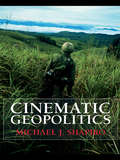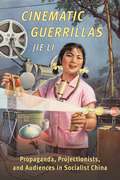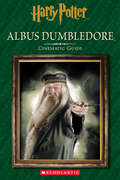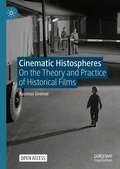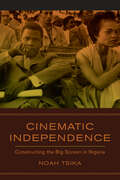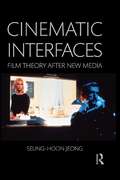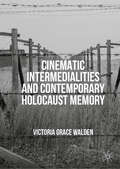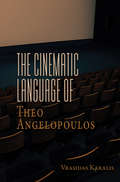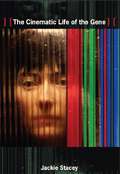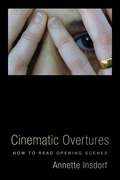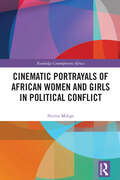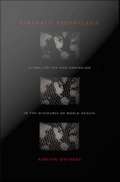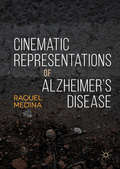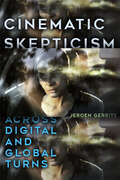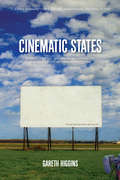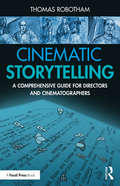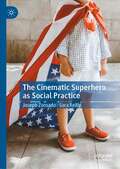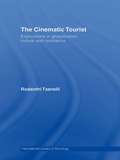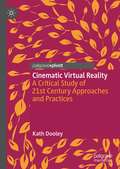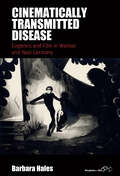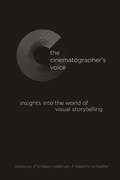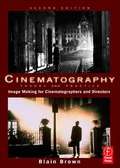- Table View
- List View
Cinematic Encounters: Interviews and Dialogues
by Jonathan RosenbaumGodard. Fuller. Rivette. Endfield. Tarr. In his celebrated career as a film critic, Jonathan Rosenbaum has undertaken wide-ranging dialogues with many of the most daring and important auteurs of our time. Cinematic Encounters collects more than forty years of interviews that embrace Rosenbaum's vision of film criticism as a collaboration involving multiple voices. Rosenbaum accompanies Orson Welles on a journey back to Heart of Darkness , the unmade film meant to be Welles's Hollywood debut. Jacques Tati addresses the primacy of décor and soundtrack in his comedic masterpiece PlayTime, while Jim Jarmusch explains the influence of real and Hollywoodized Native Americans in Dead Man. By arranging the chapters chronologically, Rosenbaum invites readers to pursue thematic threads as if the discussions were dialogues between separate interviews. The result is a rare gathering of filmmakers trading thoughts on art and process, on great works and false starts, and on actors and intimate moments.
Cinematic Encounters 2: Portraits and Polemics
by Jonathan RosenbaumEschewing the idea of film reviewer-as-solitary-expert, Jonathan Rosenbaum continues to advance his belief that a critic's ideal role is to mediate and facilitate our public discussion of cinema. Portraits and Polemics presents debate as an important form of cinematic encounter whether one argues with filmmakers themselves, on behalf of their work, or with one's self. Rosenbaum takes on filmmakers like Chantal Akerman, Richard Linklater, Manoel De Oliveira, Mark Rappaport, Elaine May, and Béla Tarr. He also engages, implicitly and explicitly, with other writers, arguing with Pauline Kael--and Wikipedia--over Jacques Demy, with the Hollywood Reporter and Variety reviewers of Jarmusch’s The Limits of Control, with David Thomson about James L. Brooks, and with many American and English film critics about misrepresented figures from Jerry Lewis to Yasujiro Ozu to Orson Welles. Throughout, Rosenbaum mines insights, pursues pet notions, and invites readers to join the fray.
Cinematic Flashes: Cinephilia and Classical Hollywood
by Rashna Wadia RichardsCinematic Flashes challenges popular notions of a uniform Hollywood style by disclosing uncanny networks of incongruities, coincidences, and contingencies at the margins of the cinematic frame. In an agile demonstration of "cinephiliac" historiography, Rashna Wadia Richards extracts intriguing film fragments from their seemingly ordinary narratives in order to explore what these unexpected moments reveal about the studio era. Inspired by Walter Benjamin's preference for studying cultural fragments rather than composing grand narratives, this unorthodox history of the films of the studio system reveals how classical Hollywood emerges as a disjointed network of accidents, excesses, and coincidences.
Cinematic Geopolitics
by Michael J. ShapiroIn recent years, film has been one of the major genres within which the imaginaries involved in mapping the geopolitical world have been represented and reflected upon. In this book, one of America's foremost theorists of culture and politics treats those aspects of the "geopolitical aesthetic" that must be addressed in light of both the post cold war and post 9/11 world and contemporary film theory and philosophy. Beginning with an account of his experience as a juror at film festival’s, Michael J. Shapiro’s Cinematic Geopolitics analyzes the ways in which film festival space and both feature and documentary films function as counter-spaces to the contemporary "violent cartography" occasioned by governmental policy, especially the current "war on terror." Influenced by the cinema-philosophy relationship developed by Gilles Deleuze and the politics of aesthetics thinking of Jacques Ranciere, the book’s chapters examines a range of films from established classics like the Deer Hunter and the Battle of Algiers to contemporary films such as Dirty Pretty Things and the Fog of War. Shapiro’s use of philosophical and theoretical works makes this cutting edge examination of film and politics essential reading for all students and scholars with an interest in film and politics.
Cinematic Guerrillas: Propaganda, Projectionists, and Audiences in Socialist China
by Jie LiHow might cinema make revolution and mobilize the masses? In socialist China, the film exhibition network expanded from fewer than six hundred movie theaters to more than a hundred thousand mobile film projectionist teams. Holding screenings in improvised open-air spaces in rural areas lacking electricity, these roving projectionists brought not only films but also power generators, loudspeakers, slideshows, posters, live performances, and mass ritual participation, amplifying the era’s utopian dreams and violent upheavals.Cinematic Guerrillas is a media history of Chinese film exhibition and reception that offers fresh insights into the powers and limits of propaganda. Drawing on a wealth of archives, memoirs, interviews, and ethnographic fieldwork, Jie Li examines the media networks and environments, discourses and practices, experiences and memories of film projectionists and their grassroots audiences from the 1940s to the 1980s. She considers the ideology and practice of “cinematic guerrillas”—at once denoting onscreen militants, off-the-grid movie teams, and unruly moviegoers—bridging Maoist iconography, the experiences of projectionists, and popular participation and resistance. Li reconceptualizes socialist media practices as “revolutionary spirit mediumship” that aimed to turn audiences into congregations, contribute to the Mao cult, convert skeptics of revolutionary miracles, and exorcize class enemies.Cinematic Guerrillas considers cinema’s meanings for revolution and nation building; successive generations of projectionists; workers, peasants, and soldiers; women and ethnic minorities; and national leaders, local cadres, and cultural censors. By reading diverse, vivid, and often surprising accounts of moviegoing, Li excavates Chinese media theories that provide a critical new perspective on world cinema.
Cinematic Guide: Albus Dumbledore (Harry Potter)
by Felicity BakerThe Essential Film Companion for ALBUS DUMBLEDORE that's perfect for the youngest fans! This hardcover guidebook features your favorite scenes and quotes from all eight Harry Potter movies!The experience of this eBook will be best if viewed on a tablet.
Cinematic Histospheres: On the Theory and Practice of Historical Films
by Rasmus GreinerIn this Open Access book, film scholar Rasmus Greiner develops a theoretical model for the concept of the histosphere to refer to the “sphere” of a cinematically modelled, physically experienceable historical world. His analysis of practices of modelling and perceiving, immersion and empathy, experience and remembering, appropriation and refiguration, combine approaches from film studies, such as Vivian Sobchack’s phenomenology of film experience, with historiographic theories, such as Frank R. Ankersmit’s concept of historical experience. Building on this analysis, Greiner examines the spatial and temporal organization of historical films and presents discussions of mood and atmosphere, body and memory, and genre and historical consciousness. The analysis is based around three historical films, spanning six decades, that depict 1950s Germany: Helmut Käutner’s Sky Without Stars (1955), Jutta Brückner’s Years of Hunger (1980), and Sven Bohse’s three-part TV series Ku’damm 56 (2016).
Cinematic Independence: Constructing the Big Screen in Nigeria
by Noah TsikaA free open access ebook is available upon publication. Learn more at www.luminosoa.org.Cinematic Independence traces the emergence, demise, and rebirth of big-screen film exhibition in Nigeria. Film companies flocked to Nigeria in the years following independence, beginning a long history of interventions by Hollywood and corporate America. The 1980s and 1990s saw a shuttering of cinemas, which were almost entirely replaced by television and direct-to-video movies. However, after 1999, the exhibition sector was revitalized with the construction of multiplexes. Cinematic Independence is about the periods that straddle this disappearing act: the immediate decades bracketing independence in 1960, and the years after 1999. At stake is the Nigerian postcolony’s role in global debates about the future of the movie theater. That it was eventually resurrected in the flashy form of the multiplex is not simply an achievement of commercial real estate, but also a testament to cinema’s persistence—its capacity to stave off annihilation or, in this case, come back from the dead.
Cinematic Interfaces: Film Theory After New Media
by Seung-hoon JeongIn this book, Seung-hoon Jeong introduces the cinematic interface as a contact surface that mediates between image and subject, proposing that this mediation be understood not simply as transparent and efficient but rather as asymmetrical, ambivalent, immanent, and multidirectional. Jeong enlists the new media term "interface" to bring to film theory a synthetic notion of interfaciality as underlying the multifaceted nature of both the image and subjectivity. Drawing on a range of films, Jeong examines cinematic interfaces seen on screen and the spectator’s experience of them, including: the direct appearance of a camera/filmstrip/screen, the character’s bodily contact with such a medium-interface, the object’s surface and the subject’s face as "quasi-interface," and the image itself. Each of these case studies serves as a platform for remapping and revamping major concepts in film studies such as suture, embodiment, illusion, signification, and indexicality. Looking to such theories as the ontology of the image and the phenomenology of the body, this original theorization of the cinematic interface not only offers a conceptual framework for rethinking and re-linking film and media studies, but also suggests a general theory of the interface.
Cinematic Intermedialities and Contemporary Holocaust Memory
by Victoria Grace WaldenThis book explores the growing trend of intermediality in cinematic representations of the Holocaust. It turns to the in-betweens that characterise the cinematic experience to discover how the different elements involved in film and its viewing collaborate to produce Holocaust memory. Cinematic Intermedialities is a work of film-philosophy that places a number of different forms of screen media, such as films that reassemble archive footage, animations, apps and museum installations, in dialogue with the writing of Deleuze and Guattari, art critic-cum-philosopher Georges Didi-Huberman and film phenomenologies. The result is a careful and unique examination of how Holocaust memory can emerge from the relationship between different media, objects and bodies during the film experience. This work challenges the existing concentration on representation in writing about Holocaust films, turning instead to the materials of screen works and the spectatorial experience to highlight the powerful contribution of the cinematic to Holocaust memory.
The Cinematic Language of Theo Angelopoulos
by Vrasidas KaralisBeginning with his first film Reconstruction, released in 1970, Theo Angelopoulos’s notoriously complex cinematic language has long explored Greece’s contemporary history and questioned European culture and society. The Cinematic Language of Theo Angelopoulos offers a detailed study and critical discussion of the acclaimed filmmaker’s cinematic aesthetics as they developed over his career, exploring different styles through which Greek and European history, identity, and loss have been visually articulated throughout his oeuvre, as well as his impact on both European and global cinema.
The Cinematic Life of the Gene
by Jackie StaceyWhat might the cinema tell us about how and why the prospect of cloning disturbs our most profound ideas about gender, sexuality, difference, and the body? In The Cinematic Life of the Gene, the pioneering feminist film theorist Jackie Stacey argues that as a cultural technology of imitation, cinema is uniquely situated to help us theorize "the genetic imaginary," the constellation of fantasies that genetic engineering provokes. Since the mid-1990s there has been remarkable innovation in genetic engineering and a proliferation of films structured by anxieties about the changing meanings of biological and cultural reproduction. Bringing analyses of several of these films into dialogue with contemporary cultural theory, Stacey demonstrates how the cinema animates the tropes and enacts the fears at the heart of our genetic imaginary. She engages with film theory; queer theories of desire, embodiment, and kinship; psychoanalytic theories of subject formation; and debates about the reproducibility of the image and the shift from analog to digital technologies. Stacey examines the body-horror movies Alien: Resurrection and Species in light of Jean Baudrillard's apocalyptic proclamations about cloning and "the hell of the same," and she considers the art-house thrillers Gattaca and Code 46 in relation to ideas about imitation, including feminist theories of masquerade, postcolonial conceptualizations of mimicry, and queer notions of impersonation. Turning to Teknolust and Genetic Admiration, independent films by feminist directors, she extends Walter Benjamin's theory of aura to draw an analogy between the replication of biological information and the reproducibility of the art object. Stacey suggests new ways to think about those who are not what they appear to be, the problem of determining identity in a world of artificiality, and the loss of singularity amid unchecked replication.
Cinematic Overtures: How to Read Opening Scenes (Leonard Hastings Schoff Lectures)
by Annette InsdorfA great movie’s first few minutes provide the key to the rest of the film. Like the opening paragraphs of a novel, they draw the viewer in, setting up the thematic concerns and stylistic approach that will be developed over the course of the narrative. A strong opening sequence leads the viewer to trust the filmmakers. Other times, opening shots are intentionally misleading as they invite alert, active participation with the film. In Cinematic Overtures, Annette Insdorf discusses the opening sequence so that viewers turn first impressions into deeper understanding of cinematic technique.From Joe Gillis’s voice-over in Sunset Boulevard as he lies dead in a swimming pool to the hallucinatory opening of Apocalypse Now, from the stream-of-consciousness montage as found in Hiroshima, mon amour to the slowly unfolding beginning of Schindler’s List, Cinematic Overtures analyzes opening shots from a range of Hollywood as well as international films. Insdorf pays close attention to how the viewer makes sense of these scenes and the cinematic world they are about to enter. Including dozens of frame enlargements that illustrate the strategies of opening scenes, Insdorf also examines how films explore and sometimes critique the power of the camera’s gaze. Along with analyses of opening scenes, the book offers a series of revelatory and surprising readings of individual films by some of the leading directors of the past seventy-five years. Erudite but accessible, Cinematic Overtures will lead film scholars and ardent movie fans alike to greater attentiveness to those fleeting opening moments.
Cinematic Portrayals of African Women and Girls in Political Conflict (Routledge Contemporary Africa)
by Norita MdegeThis book provides an interdisciplinary exploration of the cinematic representations of the experiences of African women and girls in situations of political conflict. The role of cinema is important in providing information about the situation of women and girls in situations of political conflict, and the main characters often also become signifiers of wider social, political and economic ideas, at both global and local levels. Drawing on fictional and biographical cinematic representations, this book considers films covering a range of different regions, experiences, historical periods and other contexts, to draw a nuanced picture of African women and girls who participate in or are affected by African political conflicts. The films are analysed using a decolonial feminist cultural approach, which combines cultural approaches, African feminisms and the contrapuntal method to ensure an inter-textual, intersectional and decolonial examination. The book engages with multiple themes and topics, including nationalism, nation-building, neocolonialism, memory, history, women’s and girls’ agency and activism. Through these themes and topics, the book explores how the films represent African women’s and girls’ agency in relation to their participation in social, economic and political activities. This book will make a significant contribution to literature focused on African women and girls within politics, conflict studies and film studies.
Cinematic Prophylaxiscine: Globalization and Contagion in the Discourse of World Health
by Kirsten OstherrA timely contribution to the fields of film history, visual cultures, and globalization studies, Cinematic Prophylaxis provides essential historical information about how the representation of biological contagion has affected understandings of the origins and vectors of disease. Kirsten Ostherr tracks visual representations of the contamination of bodies across a range of media, including 1940s public health films; entertainment films such as 1950s alien invasion movies and the 1995 blockbuster Outbreak; television programs in the 1980s, during the early years of the aids epidemic; and the cyber-virus plagued Internet. In so doing, she charts the changes--and the alarming continuities--in popular understandings of the connection between pathologized bodies and the global spread of disease. Ostherr presents the first in-depth analysis of the public health films produced between World War II and the 1960s that popularized the ideals of world health and taught viewers to imagine the presence of invisible contaminants all around them. She considers not only the content of specific films but also their techniques for making invisible contaminants visible. By identifying the central aesthetic strategies in films produced by the World Health Organization, the Centers for Disease Control, and other institutions, she reveals how ideas about racial impurity and sexual degeneracy underlay messages ostensibly about world health. Situating these films in relation to those that preceded and followed them, Ostherr shows how, during the postwar era, ideas about contagion were explicitly connected to the global circulation of bodies. While postwar public health films embraced the ideals of world health, they invoked a distinct and deeply anxious mode of representing the spread of disease across national borders.
Cinematic Representations of Alzheimer’s Disease
by Raquel MedinaThis book offers a cross-cultural approach to cinematic representations of Alzheimer’s disease in non-mainstream cinema. Even though Alzheimer’s disease, the most common form of dementia, is a global health issue, it is not perceived or represented homogenously around the world. Contrary to very well-known mainstream films, the films discussed do not focus on the negative aspects normally associated with Alzheimer’s disease, but on the importance of portraying the perspective of the persons living with Alzheimer’s and their personhood. Similarly, this book analyses how the films use Alzheimer’s as a trope to address issues relating to different areas of life and society such as, for example, family matters, intergenerational relationships, gender issues, national traditions versus global modernity, and caring for people with dementia. By examining an array of films, from crime fiction to documentary, that each present non-stigmatising representations of Alzheimer’s disease, this in-depth study ultimately demonstrates the power of culture in shaping meaning.
Cinematic Skepticism: Across Digital and Global Turns
by Jeroen GerritsBecause of its automatic way of recording reality, film has a privileged relation to the problem of skepticism. If early film theorists celebrate cinema for overcoming skeptical doubt about the power of human vision, recent film-philosophers argue that our postphotographic, digital cinema is heading toward a general acceptance of skepticism, as though nothing on screen has anything to do with reality any longer. Emerging from the interaction of Stanley Cavell's and Gilles Deleuze's film-philosophies, Cinematic Skepticism challenges both these views. Jeroen Gerrits takes the issue of skepticism beyond concern with knowledge, turning skepticism into an ethical problem that pervades film history and theory. At the same time, he rethinks a Cavello-Deleuzian approach across the digital and global turns in cinema. Combining clear explanations of complex philosophical arguments with in-depth analyses of the contemporary films Grizzly Man, Amélie, Three Monkeys, and The Headless Woman, Gerrits traces how cinema invents ways of dis/connecting to the world.
Cinematic States: Stories We Tell, the American Dreamlife, and How to Understand Everything*
by Gareth HigginsA Northern Irish writer explores his adopted homeland through film in this irreverent yet moving journey through each of the 50 states. Set among a personal backdrop of immigration memoir, he takes on American myths in their most powerful form--the motion picture--by setting out to determine if a Kansas yellow brick road really does lead to the end of the rainbow, and whether it first has to pass through Colorado's Overlook Hotel. Amid the multipurpose woodchippers, friendly exorcists, and faulty motel showers, resurrected baseball players, and miracle-working gardeners, he examines what the stories we tell reveal about American lives and uses this to sum up what he has learned about the promises, failures, and hope that is America.
Cinematic Storytelling: A Comprehensive Guide for Directors and Cinematographers
by Thomas RobothamThis book presents a new, story-based approach to cinematic coverage and storytelling in film and video. It breaks from the conventional idea that shots are the fundamental unit of filmmaking, instead exploring the specifics of determining coverage. Keyframes in patterns are introduced, delivering scripted material in a context-rich presentation that supports the storytelling. All the analysis, interpretation, and creative decision making is done first, with shots derived as the very last step. Scripted material is divided into six categories with associated patterns. Like cinematic building blocks, these can freely stack up and interconnect, supporting creativity and avoiding rigid formulas. This approach enables filmmakers to tap into the film "language" that audiences already understand and put it to practical use, helping the audience to feel the storytelling deeply. Dozens of film examples are provided throughout, plus conceptual and camera diagrams to contextualize the methods presented, and exercises are provided to reinforce concepts. Emphasis is placed on supporting performance and story meaning through a cinematic context. With all the concepts and decision-making options described and shown in examples, a scripted scene is analyzed and developed through an eight-step process, illustrated with storyboard, camera diagrams, and ultimately shot list descriptions. The book is ideal for filmmaking students interested in directing and cinematography, as well as aspiring and early-career filmmakers, cinematographers, and directors.
The Cinematic Superhero as Social Practice
by Joseph Zornado Sara ReillyThis book analyzes the cinematic superhero as social practice. The study’s critical context brings together psychoanalysis and restorative and reflective nostalgia as a way of understanding the ideological function of superhero fantasy. It explores the origins of cinematic superhero fantasy from antecedents in myth and religion, to twentieth-century comic book, to the cinematic breakthrough with Superman (1978). The authors then focus on Spider-Man as reflective response to Superman’s restorative nostalgia, and read MCU’s overarching narrative from Iron Man to End Game in terms of the concurrent social, political, and environmental conditions as a world in crisis. Zornado and Reilly take up Wonder Woman and Black Panther as self-conscious attempts to reflect on gender and race in restorative superhero fantasy, and explore Christopher Nolan’s Dark Knight trilogy as a meditation on the need for authoritarian fascism. The book concludes with Logan, Wonder Woman 1984, and Amazon Prime’s The Boys as distinctly reflective fantasy narratives critical of the superhero fantasy phenomenon.
The Cinematic Tourist: Explorations in Globalization, Culture and Resistance (International Library of Sociology)
by Rodanthi TzanelliRecent years have seen a radical transformation of conventional tourist marketing and experience. The use of exotic locations in Hollywood films has allowed global audiences to enjoy distant places. Simultaneously, Hollywood screening of potential 'tourist paradises' has generated new tourist industries around the world. This book takes a closer look at this new phenomenon of 'cinematic tourism', combining theory with case studies drawn from four continents: America, Europe, Asia and Australasia. The author explores audiences' perceptions of film and their covert relationship with tourist advertising campaigns, alongside the nature of newly-born tourist industries and the reaction of native populations and nation-states faced with the commodification of their histories, identities and environments.
Cinematic Virtual Reality: A Critical Study of 21st Century Approaches and Practices
by Kath DooleyWith reference to traditional film theory and frameworks drawn from fields such as screenwriting studies and anthropology, this book explores the challenges and opportunities for both practitioners and viewers offered by the 360-degree storytelling form. It focuses on cinematic virtual reality (CVR), a format that involves immersive, high quality, live action or computer-generated imagery (CGI) that can be viewed through head mounted display (HMD) goggles or via online platforms such as YouTube. This format has surged in popularity in recent years due to the release of affordable high quality omnidirectional (360-degree) cameras and consumer grade HMDs. The book interrogates four key concepts for this emerging medium: immersion, presence, embodiment and proximity through an analysis of innovative case studies and with reference to practitioner interviews. In doing so, it highlights the specificity of the format and provides a critical account of practitioner approaches to the concept development, writing and realisation of short narrative CVR works. The book concludes with an account of the author’s practice-led research into the form, providing a valuable example of creative practice in the field of immersive media.
Cinematically Transmitted Disease: Eugenics and Film in Weimar and Nazi Germany (Film Europa #28)
by Barbara HalesPropaganda played an essential role in influencing the attitudes and policies of German National Socialism on racial purity and euthanasia, but little has been said on the impact of medical hygiene films. Cinematically Transmitted Disease explores these films for the first time, from their inception during the Weimar era and throughout the years to come. In this innovative volume, author Barbara Hales demonstrates how medical films as well as feature films were circulated among the German people to embed and enforce notions of scientific legitimacy for racial superiority and genetically spread “incurable” diseases, creating and maintaining an instrumental fear of degradation in the German national population.
The Cinematographer's Voice: Insights into the World of Visual Storytelling (SUNY series, Horizons of Cinema)
by Lindsay Coleman; Roberto SchaeferThe Cinematographer's Voice is a unique exploration of contemporary filmmaking and cinematography. The distillation of more than one-hundred interviews with cinematographers from around the world, and the product of a decade's worth of scholarship, the book is not only a collection of interviews with some of the world's leading cinematographers, but also a panoramic sweep of what image-making means in the era of digital cinema. Frequently, cinematography may seem intimidating as a discipline, the preserve solely of practitioners who have learned, through years of exposure to photographic technology, both the required jargon and background knowledge to comfortably engage with an often-technical field. In our present era of film studies, this is no longer the case. The interviews collected here are informative not only on matters of technique, but also on the ways in which practitioners formulate their methodologies, work with directors, and engage with the many logistical hurdles of visual storytelling. The result is an oral history of the past forty years of filmmaking and the cinematography it has produced.
Cinematography: Theory and Practice
by Blain BrownThere's more to being a DP than holdng a light meter! With this book as your guide, you are on your way to learning not only about the equipment and technology, but also about the concepts and thought processes that will enable you to shoot professionally, efficiently, and with artistic mastery. A leading book in the field, Cinematography has been translated into many languages and is a staple at the world's top film schools. Lavishly produced and illustrated, it covers the entire range of the profession. The book is not just a comprehensive guide to current professional practice; it goes beyond to explain the theory behind the practice, so you understand how the rules came about and when it's appropriate to break them. In addition, directors will benefit from the book's focus on the body of knowledge they should share with their Director of Photography.Cinematography presents the basics and beyond, employing clear explanations of standard practice together with substantial illustrations and diagrams to reveal the real world of film production. Recognizing that professionals know when to break the rules and when to abide by them, this book discusses many examples of fresh ideas and experiments in cinematography. Covering the most up-to-date information on the film/digital interface, new formats, the latest cranes and camera support and other equipment, it also illustrates the classic tried and true methods.
